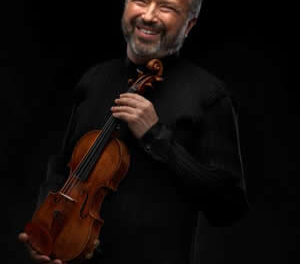Tuba recitals, in my experience, ostensibly share a few traits. Their programs usually include a slew of contemporary solo tuba-and-piano works and often a transcription or two from a simpler pre-tuba era. They usually occur in an academic or university setting, whether given by professors, guest professionals, or students. They are almost always — unjustifiably — sparsely attended. And they often provide thought-provoking, aurally tantalizing experiments in repertoire, style, and composition unique to a solo instrument that’s only recently arrived as a viable medium for art music.
Dennis AsKew’s tuba recital was no different. The UNC-Greensboro Professor of Tuba and Euphonium and his accompanist, renowned pianist Nancy Allen Davis, performed a difficult program split between mostly technical transcriptions and songlike contemporary works for tuba and piano with impressive musicality and execution.
AsKew chose G.F. Handel’s Concerto in G minor, originally composed for oboe, to open the program. Transcriptions like these present an irresistible challenge: prove that you and your instrument can live up to a standard set by 400 years of works by the great-great-great granddaddies of Western music and deliver musically and stylistically. Through four movements of precise, rapid-fire sequences and gracefully executed trills, AsKew’s performance demonstrated how necessity — breathing for tuba rather than oboe — could be adapted into a unique but appropriate stylistic interpretation that allows for musicality and keeps the performer from keeling over in his or her chair from lack of oxygen.
Next came a transcribed version of Alexandre Glazunov’s soaring, romantic “Chant du Menestral.” AsKew’s tone and stylistic treatment of this piece was highly vocal, although his sound lost its, er, composure a little at the ultimate climax. To close the half, AsKew returned to his brass roots with “The Harp That Once Thro’ Tara’s Halls” by seminal cornetist Herbert L. Clarke, one of the forebears of modern brass playing. AsKew seemed to lose dynamic control over the fantasia section but stabilized to deliver a playfully elastic, soaring technical cadenza and three thematic variations of increasing technical difficulty. The sextuplets in the dizzying final variation sounded light as cotton balls popping from a machine gun.
A note on contemporary tuba pieces: really, there isn’t any other kind. The tuba didn’t gain status as a solo instrument until the mid-twentieth century; today, tubists and euphoniumists get their fair share of new works by accomplished composers like Derek Bourgeois and James Grant, whose works made up the program’s second half. Upon launching into Bourgeois’ “Romance, Op. 77,” AsKew’s tone and style immediately sounded 25% freer and more relaxed — a combination of the intermission break and the psychological relief of hitting the home stretch, perhaps. This piece highlights Davis in a crashing, angular interlude, pitting a driven syncopated left hand against cascading lines in the right, which leaves the audience prepped to downshift for AsKew’s brooding, dark cadenza.
James Grant’s best known tuba piece is probably “Three Furies,” a sometimes whimsical, sometimes aggressively bizarre three-part work. “Chocolates” is also a set of three movements, but the similarities end there. In movements “Godiva,” “Bittersweet,” and “Triple Mocha Indulgence,” sweetly sad, bluesy torch songs are suited to the tuba’s potential for smooth lyrical playing. AsKew’s treatment of the tuba melody evoked a sultry, dolorous jazz singer’s emotionally frank performance and was the unquestionable highlight of the program.
The closer, “Just a Thought,” is one of a group of Grant’s short pieces commissioned by a consortium of tubists. Its lyrical style and meditative tone served as a calming palate cleanser. The quality and variety of AsKew and Davis’ performance showed that the tuba is continuing to gain ground as a fascinating solo voice in art music, even if this growth is mostly under the radar — for now, anyway.











